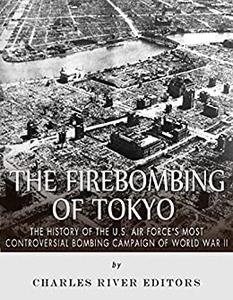

E-Books →The Firebombing of Tokyo The History of the U.S. Air Force's Most Controversial Bombing Campaign of World War II
Published by: voska89 on 2-08-2022, 19:35 |  0
0

The Firebombing of Tokyo: The History of the U.S. Air Force's Most Controversial Bombing Campaign of World War II by Charles River Editors
English | June 22, 2015 | ISBN: 1514609045 | 70 pages | EPUB | 3.58 Mb
*Includes pictures *Includes accounts of the firebombing by both Americans and Japanese civilians in Tokyo *Includes online resources and a bibliography for further reading *Includes a table of contents "Maj. Gen. Curtis E. LeMay, commander of the B-29s of the entire Marianas area, declared that if the war is shortened by a single day, the attack will have served its purpose." - The New York Times As American forces pushed the Japanese back across the Pacific from 1942-1944, their island-hopping campaign ultimately made it possible for the Air Force to conduct bombing runs over the Japanese mainland. The first serious air raids came in November 1944, after the Americans had captured the Marianas Islands, and through February 1945, American bombers concentrated on military targets at the fringes of the city, particularly air defenses. However, the air raids of March 1945, and particularly on the night of March 9, were a different story altogether. In what is generally referred to as strategic or area bombing, waves of bombers flew low over Tokyo for over two and a half hours, dropping incendiary bombs with the intention of producing a massive firestorm. The American raids intended to produce fires that would kill soldiers and civilians, as well as the munitions factories and apartment buildings of those who worked in them. 325 B-29s headed toward Tokyo, and nearly 300 of them dropped bombs on it, destroying more than 267,000 buildings and killing more than 83,000 people, making it the deadliest day of the war. The firebombing that night and morning left 25% of Tokyo charred, with the damage spread out over 20 miles of the metropolis. In fact, the damage was so extensive that casualty counts range by over 100,000. Additional raids, this time largely on the north and west, came in April, and in May, raids hit Ginza and the south. Altogether, American bombers flew more than 4,000 missions over Tokyo before surrender. The damage was spread widely, but it was worst in the low city, where some neighborhoods were virtually depopulated as survivors fled to the relative safety of the countryside. Honjo and Fukagawa each lost roughly 95% of their pre-raid populations. In 1940, Tokyo was a city of perhaps 6.8 million, but two years after the end of the war, when the population had already begun to increase again, it was still no more than 4.1 million. As with dropping the atomic bombs on Hiroshima and Nagasaki, the firebombing of Tokyo has remained controversial since the end of World War II. Japan had wisely spread out its industrial facilities across Tokyo so that one concerted attack could not deal a severe blow to its military capabilities. However, by spreading everything out, as the Germans had also done, Allied planes hit targets in residential zones, greatly increasing the casualties. Thus, by destroying as much of Tokyo's wartime manufacturing as possible, the American air force also destroyed half the city. Of course, it's far easier with the advantage of hindsight for people to call the campaign disproportionate, especially since the bombing campaign came at a time when the United States still faced the dreadful prospect of invading Japan's mainland. In 2007, Japanese Prime Minister Abe Shinzo took responsibility for Japan's refusal to surrender when defeat was inevitable, thus placing the blame for the firebombing on Japan itself. Shinzo announced that Japan would financially compensate survivors and bereaved family members of those killed, and shortly after the announcement, 112 survivors filed a lawsuit seeking damages for damage done during the campaign. The Firebombing of Tokyo: The History of the U.S. Air Force's Most Controversial Bombing Campaign of World War II chronicles the background of the campaign, its destruction, and its notorious legacy. Along with pictures of important people, places, and events, you will learn about the firebombing of Tokyo like never before, in no time at all.
Buy Premium From My Links To Get Resumable Support,Max Speed & Support Me
https://www.uploadcloud.pro/69hey2nyxqwh/h6jbq.T.F.o.T.T.H.o.t.U.S..A.F.M.C.B.C.o.W.W.I.rar.html
Download from NovaFile
https://nfile.cc/VqgJWa7L/h6jbq.T.F.o.T.T.H.o.t.U.S..A.F.M.C.B.C.o.W.W.I.rar

https://uploadgig.com/file/download/62a6f62167986299/h6jbq.T.F.o.T.T.H.o.t.U.S..A.F.M.C.B.C.o.W.W.I.rar

https://rapidgator.net/file/045c7541e1c01f34bae700353688e2d5/h6jbq.T.F.o.T.T.H.o.t.U.S..A.F.M.C.B.C.o.W.W.I.rar.html

https://nitroflare.com/view/825B2F1FC682240/h6jbq.T.F.o.T.T.H.o.t.U.S..A.F.M.C.B.C.o.W.W.I.rar
Links are Interchangeable - No Password - Single Extraction
Related News
-
{related-news}

